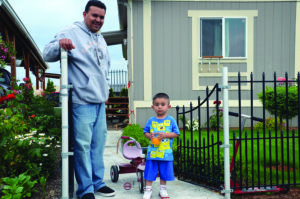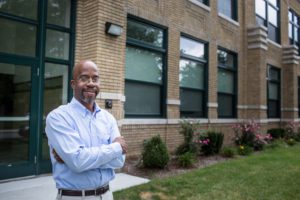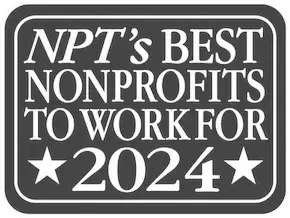Reflections on 1968: Fostering Equity and Justice in 2018 and Beyond
By Ellis Carr, President and CEO
This has been a year of reflection and introspection for me. In 2017, Capital Impact Partners, a national Community Development Financial Institution (CDFI), had its best year since our founding in the early 1980s. We implemented new programs and innovative products to unlock opportunity for underserved communities across the country, and, I am proud to say, deployed record volumes in support of economic, social, and racial justice – and have continued that critical work in 2018.
Despite our recent successes, our accomplishments sometimes feel hollow given the growing wealth gap, wage stagnation, and continuing racial and social injustice. Many Americans, including some of my own family, feel that opportunity is out of reach.
As I reflect on 2018, I remember another year that marked great change for the country and had lasting implications for how we as a society ensure that all residents have access to equity and justice under the law.
2018 marks the 50th anniversary of three key events that were instrumental in the civil rights movement. In 1968, the Kerner Report, Martin Luther King, Jr.’s assassination, and the Fair Housing Act required Americans to examine their actions and reconcile them with their belief in freedom, justice, equality. These historic events showed a potential path for a more inclusive and prosperous America for all, but as I look back, I find myself asking: How much further along are we as a society than we were 50 years ago and what can we learn from the past in order to create a more just and equitable future?
Reflecting on the Kerner Commission Findings
Racial tensions rose in 1967 and built into riots that spanned the nation. As a result, President Lyndon B. Johnson convened the National Advisory Commission on Civil Disorders (known as the Kerner Commission for the commission chair) to determine the exact causes of the unrest. Their 426-page report stated plainly that “racism is essentially responsible for the explosive mixture which had been accumulating in our cities.” The many “ingredients” listed in the findings included:
- Pervasive discrimination and segregation in employment, education, and housing which resulted in communities of color being excluded from the benefits of economic progress;
- Lack of investment creating deteriorating facilities and unmet human needs, especially focused in areas of growing concentrations of impoverished Black communities;
- Crippling poverty impacting the younger generation and enforcing failure;
- Police brutality in the form of harassment and physical and verbal abuse; and
- The frustrations of powerlessness and alienation felt by these communities.
Several important policy recommendations were put forward to address these issues, including creating more and better jobs, expanding education and ending school segregation, providing pathways out of welfare, and ensuring affordable and safe housing. In addition, the commission addressed other key issues such as police interactions, criminal justice, and even media portrayals of Black Americans.
Especially critical was the underlying theme that change in communities must not be made solely from the outside, but that “people within them should have a voice.”
Dr. Martin Luther King, Jr. praised the approach, noting that it was a “physician’s warning of approaching death, with a prescription for life.” However, just two months later, Dr. King, the leading crusader for social and racial justice in the United States, was assassinated.

Affordable housing is a critical element of financial stability; the Fair Housing Act promised low-income families the chance at shared prosperity.
As a shell-shocked nation mourned and tried to begin picking up the pieces, there was a glimmer of hope. The Civil Rights Act of 1968 (also known as the Fair Housing Act) was passed to outlaw housing discrimination and foster integration.
These pivotal moments in our history had an immense impact on the nation, informing what should be our responsibility to each other. The right to affordable housing, quality education, and health care. The right to safe and prosperous communities. The right to full privileges for all under the law. The right to equitable opportunity.
50 Years Later – Where Do We Stand?
Without question, those momentous events have led to gains for communities of color. There is a recognition and tolerance of the innate civil liberties of people of color. People of all races can share the same spaces, hold the same jobs, go to the same schools, live in the same communities, but our society remains deeply racially divided.
I am struck, however, by the list of underlying issues originally put forth by the Kerner Commission. If someone read those to me without the historic context, I could easily imagine that they were referring to issues that so many of our communities face today.
Continued prejudice has solidified the systemic practices that have denied equitable opportunity to countless individuals. Wealth creation, job opportunities, quality education, and affordable housing are still out of reach for many. Issues of police brutality abound. Political discourse and action has continued to be exclusive, furthering barriers to success.
Groups – particularly people of color – are only marginally better off than 50 years ago, and are falling far behind white Americans at a faster pace than ever. The wealth gap between white families and their Black and Hispanic counterparts has more than tripled in the last 50 years, according to Federal Reserve data and census data.
Black men fare worse economically than white men, even if they are raised in households with similar incomes and are educated similarly. Most women of color face a double disparity: having lower socio-economic outcomes than men, compounded by a racial identity that has much lower socio-economic outcomes than their white counterparts, even though women’s graduation rates tend to be higher.
Economic inequity also comes in the form of discriminatory consumer and credit practices. Many communities of color have few banking options, leaving space for predatory lending practices. When banks offer services to individuals of color, they are often less affordable, with higher fees and less flexibility.

Investing in creating vibrant communities through social services like affordable housing reduces the barriers that low-income individuals, often people of color, face.
Affordable housing is limited across the country, regardless of race or location. A particularly high burden falls on minorities, who have higher percentages of low-wage work and whose savings are less robust than their white peers. Outright policy discrimination like redlining has consigned minority families to “the ghetto,” recognized by the Kerner Commission as urban spaces of entrenched poverty and acute social disorganization, creating involuntary segregation for people of color. Not only do our “ghettos” still exist, but they’ve expanded well beyond our city limits.
Add to this systemic disinvestment the epidemic of mass incarceration – in which prisons constitute ghettos of another kind – and the structural stripping of wealth and opportunity reaches its peak. Nationwide, there are 44,000 federal, state, and local barriers to reentry into society for returning citizens, including housing, employment, finances, and civil liberties like voting rights. The costs of these barriers are heavy, including diminished long-term accumulated wealth, devastated health outcomes, and eroded relationships.
If this is not the world that we want, we need to ask ourselves the hard questions. For us to be great – better than the day before or 50 years prior – we need to take time to reflect, to learn from what has happened, then and now. We need to think and act differently.
Asking Important Questions to Forge a Path to Shared Prosperity
The solutions laid out by the Kerner Commission are critical to maintaining a strong economy and peaceful coexistence. When all people living in America have the ability to succeed, everyone prospers.
As leader of a mission-driven organization, I believe that it is imperative to consistently question our strategies and tactics and explore what will best serve marginalized communities. If we are going to accelerate the pace of change, we need to start by asking ourselves:
- Why have we not seen more social and economic progress during the last 50 year?
- Have we become too complacent, too siloed?
- Are we too focused on organizational success, rather than broader societal advancement?
- How can we support a broader public policy agenda that creates opportunities for more Americans?
Conclusion:
After 50 years, many Americans feel like the promise of Martin Luther King, Jr., the Kerner Report, and the Fair Housing Act have not been fully realized. It is incumbent upon us to ensure that we develop sustainable solutions that move us from a dream deferred to a promise realized.







